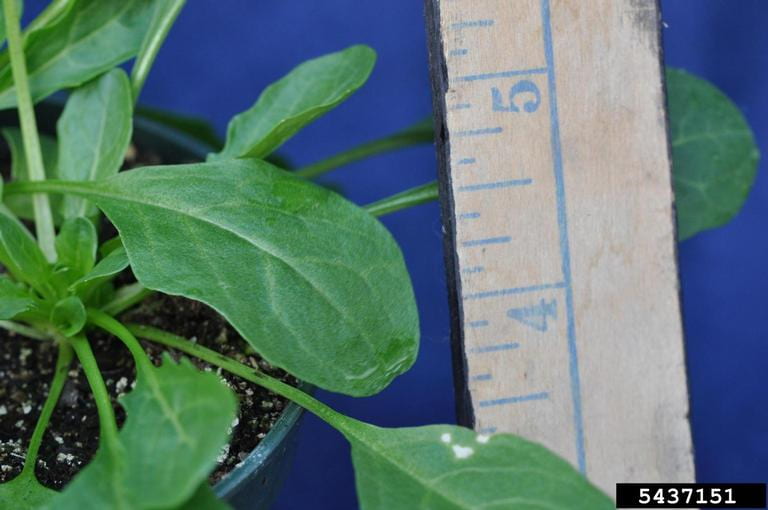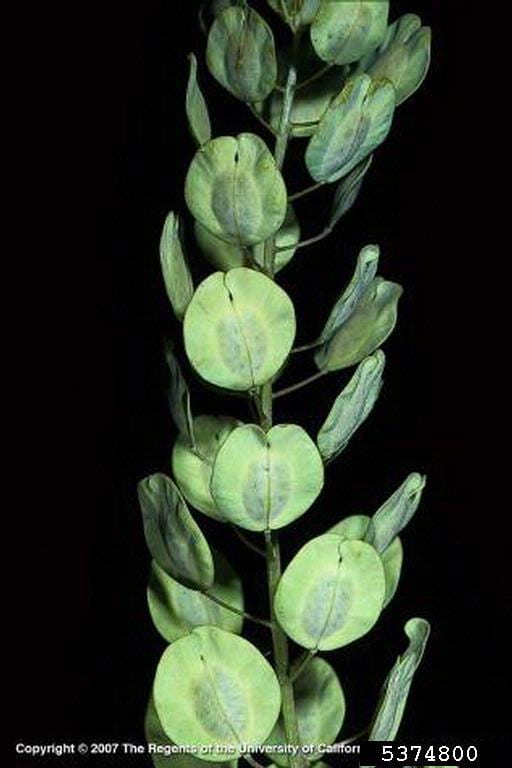Field pennycress (Thlaspi arvense) is a winter or summer annual weed of agricultural lands, including horticulture crops and nurseries. This weed typically grows in nutrient-rich soil in cultivated areas. When bruised, stems and foliage of the plant produce a rank, garlic-like smell that helps identify it from other small mustards. If eaten by cattle, field pennycress can produce an off taste in meat and milk products, and can cause poisoning of cattle and pigs if eaten in large quantities, from increased sensitivity of skin to sun exposure to mild digestive issues to colic and abortion.
Field pennycress is one of 3000+ species in the mustard family. For help identifying weedy mustards either in the rosette or flowering phase, please visit our mustard identification page.
Identification
Seedlings: Cotyledons of field pennycress are bluish-green, 6-8 mm (up to 3/10”) long, 5-6 mm (up to 1/4”) wide and unequally sized, and oval shaped with distinct petioles and downward-curving tips. The first leaves are opposite, oval-shaped, and smooth or wavy-margined; subsequent early leaves are alternate, have wavy margins and form a basal reostte.
Leaves: Mature leaves are light green, contain no hairs, and form in a rosette. Leaf margins can be entire or toothed, and the leaf bases clasp the stem. Leaves towards the base of the plant are narrowly egg-shaped with 1.3-5 (up to 1/5”) cm long petioles. Leaves on the upper portion of the plant are smooth on the surface and oblong to lance-shaped.
Detail view of mature field pennycress leaves
Photo by Bruce Ackley of the Ohio State University via Bugwood.org
Mature plant: Plants are up to ~3/4m (32″) tall, with flower-producing stems that are smooth, erect, and unbranched or just branched on the top portion of the plant. Basal rosette leaves are present even when the plant is flowering. The root system has a thin taproot which produces many fibrous roots.
Flowers/Fruit: Flowers bloom from April to June. The tiny flowers are 3-4 mm (up to 1/5” in diameter) with 4 white petals (3-4 mm long (up to 1/5”)). Flowers bloom in dense heads that grow into spikes, and seeds form at the bottom while the plant continues to flower at the top of the spike.
Field pennycress fruit are flat, circular to elliptic, and notched (2-3 mm (up to 1/10”)) at the tip. About 1.3 cm (~1/2”) in diameter, the fruit are have a papery ‘wing’ around the central seed capsule. When ripe, the seed capsule splits in half to release 2-8 seeds per side. One plant can produce up to 15,000 seeds.
Management
Chemical control
While no herbicide resistance has been reported for this species in the US, Group 2 (ALS inhibitor) resistance has been documented in three Canadian provinces, often in wheat fields but also in spring barley, canola, and peas.
New York specific guidance can be found in the Cornell Crop and Pest Management Guides, or click above for the chemical control of field pennycress from Cornell’s turfgrass and weed weed identification app.
Non-chemical control
Managing seed production is important for this species given how prolific each plant can be. Tilling and removing plants by hand, both done before flowering begins, have shown to be the most effective forms of management. For mechanical removal, grubbing, digging, or hand-pulling are all viable methods. Rotating with summer-planted crops and cultivating in the early spring during a fallow year of grain also help with field pennycress management. When planting competitive crops against this weed, it is recommended to do so with tall and leafy small grain plants.
Species Similar to Field Pennycress
Table 1: Shows field pennycress (Thlaspi arvense) similarities and differences in identification compared to its similar species .| Species | Similarities | Differences |
|---|---|---|
| Field pepperweed (Thlaspi arvense) | white to greenish flowers in clusters, erect flower stem, narrow leaves which taper at the end | hairy leaves |
References
Uva R H, Neal J C, DiTomaso J M. 1997. Weeds of the Northeast. Book published by Cornell University, Ithaca NY. The go-to for weed ID in the Northeast; look for a new edition sometime in 2019.
Toxic Plants of North America, second edition. George E. Burrows and Ronald J. Tyrl, 2013, published by Wiley-Blackwell. ISBN 978-0-8138-2034-7.
Cornell University’s Turfgrass and Landscape Weed ID app. Identification and control options for weeds common to turf, agriculture, and gardens in New York; uses a very simple decision tree to identify your weed.
Organic management suggestions are from Dr. Charles Mohler of Cornell University. Look for an upcoming book from Dr. Mohler on ecological management of weeds, from Cornell University Press.
A Mustard Identification Workshop by Tim Miller of the Washington State University via the Weed Conference. Document on mustard identification with dichotomous key.
University of Missouri’s Integrated Pest Management webpage. Identification information and images for field pennycress.









